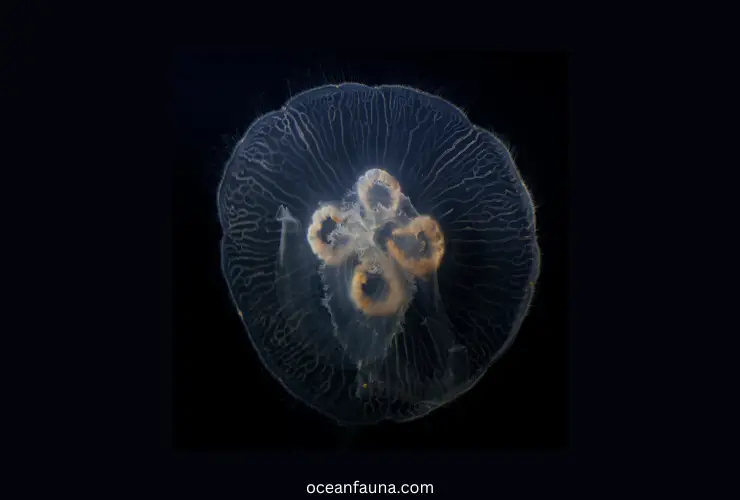Moon jellyfish, also known as Aurelia Aurita, are a fascinating species of jellyfish found in temperate and tropical oceans worldwide. These creatures are part of the cnidarian family, including corals, sea anemones, and other jellyfish species. They are named after their four crescent-shaped reproductive organs, which resemble the moon.
Moon jellyfish are unique in appearance, with translucent, bell-shaped bodies that can range in size from just a few centimeters to 40 centimeters in diameter.
Let’s learn more about these creatures in this article!
About Moon Jellyfish – A Quick Biology
| Parameters | Details |
| Scientific name | Aurelia aurita |
| Kingdom | Animalia |
| Family | Ulmaridae |
| Genus | The genus Aurelia |
| Phylum | Cnidaria |
| Class | Scyphozoa |
| Order | Semaeostomeae |
| Species | Moon jellyfish were considered a single species historically. |
| Habitat | Estuaries and harbors (close to the shore.) |
| Life Span | 8 to 12 months. |
| Diet | Carnivorous |
| Geographical range | Southern Greenland, Northern Eurasia, all of North and South America, and all coasts of Australia. |
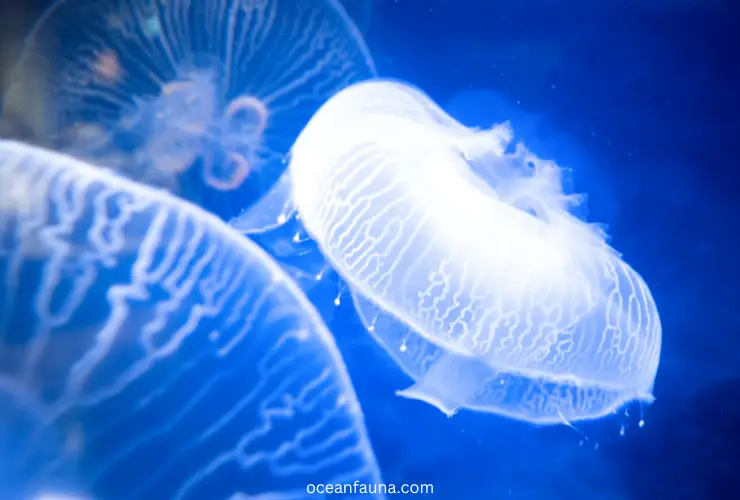
Description And Anatomy of Moon Jellyfish
Moon jellyfish are unique and fascinating creatures with bells that are composed of a thin, elastic layer of tissue called the mesoglea.
This tissue is sandwiched between two layers of cells, helping maintain the shape of the bell.
They do not have a digestive system, a circulatory system, or a respiratory system. Fascinating, right?
These jellyfish rely on a nerve that controls both feeding and swimming.
The mouth is located on the underside of the jellyfish’s bell and leads to a short digestive cavity called the gastrovascular cavity.
Digestion takes place in the gastro-vascular cavity through the gastro-dermis. Here, nutrients are absorbed from the food the jellyfish consumes.
This cavity is surrounded by small, branching canals that distribute nutrients throughout the jellyfish’s body.
Fun Fact: One of the unique features of moon jellyfish is their ability to regenerate their tissues. If a portion of their bell or tentacles is damaged or removed, the jellyfish can regenerate the missing tissue over time. ~ BBC Earth
Physical Characteristics/ Appearance of Moon Jellyfish
Moon jellyfish, also known as saucer jellyfish, are beautiful and delicate creatures that exhibit radial symmetry. They are characterized by a translucent, saucer-shaped bell that can range in diameter from 10 to 35 centimeters.
The bell is usually a pale, bluish-white color and has a distinctive cross-like pattern made up of four gonads that are visible through the bell.
The outer dome-shaped bell has gonads running through it that look like blue veins. These blue veins are connected with mesmerizing colorings and patterns.
The edges of the bell are fringed with short, delicate tentacles that are covered with thousands of tiny, hair-like cilia. These cilia create a gentle water current that helps the jellyfish move through the water and capture prey.
The jellyfish’s four oral arms hang from the center of the bell and are lined with small, sticky tentacles called cnidocytes.
These cells contain tiny, harpoon-like structures called nematocysts that help the jellyfish capture and immobilize its prey.
One of the most striking features of moon jellyfish is their luminescence.
The jellyfish have specialized cells on their tentacles and oral arms called cnidocytes that contain tiny, stinging nematocysts.
When triggered, these nematocysts release a bioluminescent chemical that causes the jellyfish to glow in the dark.
Behavior of Moon Jellyfish
Moon jellyfish have a relatively simple behavioral repertoire, as they lack the complex nervous system found in many other marine animals. However, they do exhibit many interesting behaviors that are worth noting.
One of the most distinctive behaviors of moon jellyfish is their pulsing motion, which allows them to swim and maneuver through the water.
They rhythmically contract their bell-shaped bodies, creating a jet of water that propels them forward.
This pulsing motion is controlled by a nerve ring at the base of the jellyfish’s bell and helps the jellyfish navigate through their environment.
Moon jellyfish are also able to orient themselves in response to gravity and light.
They are positively phototactic, meaning they move towards sources of light. Also, they will often congregate near the surface of the water where sunlight is most abundant.
They can also sense the direction of gravity and will adjust their pulsing motion to maintain an upright position.
The calcium sulfate crystals in their bells move with gravity, indicating to the jellyfish whether they are moving upwards or downwards.
In addition to these behaviors, moon jellyfish are also known to aggregate in large groups, or blooms, during certain times of the year.
These blooms can consist of thousands or even millions of jellyfish and can significantly impact marine ecosystems.
Moon jellyfish blooms can alter the food chain by consuming large amounts of zooplankton, which can in turn impact other organisms that rely on these organisms as a food source.
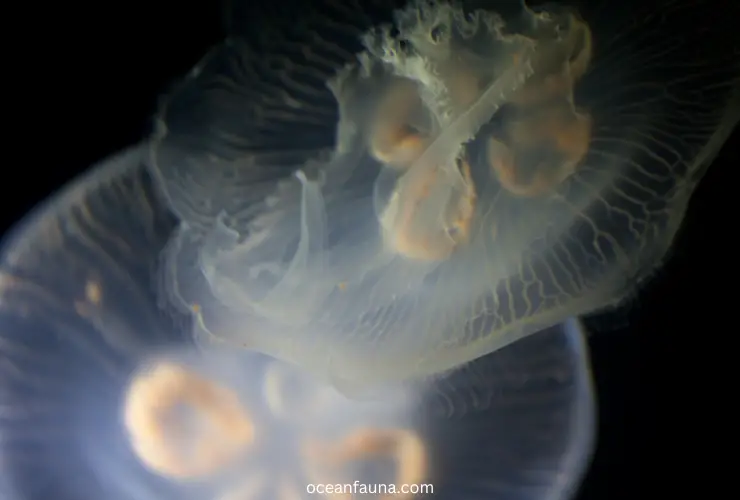
Habitat, Range, And Distribution of Moon Jellyfish
Moon jellyfish are found in a wide range of habitats across the world’s oceans.
They are native to both tropical and temperate waters and can be found in a variety of marine environments, from shallow bays and estuaries to open ocean waters.
Moon jellyfish have a semi-cosmopolitan distribution, which is found in the world’s oceans. They are particularly common in the Atlantic Ocean, but can also be found in the Pacific and Indian Oceans.
These magnificent creatures can survive in waters with low salinity and high pollution levels. They can tolerate fluctuations in water temperature and other physical conditions.
This adaptability allows them to thrive in a variety of coastal and open ocean habitats. So, when ocean health declines, there is little to no effect on moon jellyfish populations.
Feeding Habits / Diet of Moon Jellyfish
Moon jellyfish are carnivorous and feed on a variety of small organisms that they capture with their tentacles.
Their diet primarily consists of planktonic animals such as copepods, crustacean larvae, small fish, and other small jellyfish.
To catch their prey, moon jellyfish use their tentacles, which are covered in thousands of tiny stinging cells called nematocysts.
When a potential prey item comes into contact with a jellyfish’s tentacles, the nematocysts fire and release a toxin that immobilizes the prey.
The jellyfish then brings the captured food to its mouth, located at the center of its bell-shaped body.
This is possible because they have a specialized mucus layer on their tentacles that helps to trap small food particles and bring them to the jellyfish’s mouth.
In addition to capturing food with their tentacles, moon jellyfish can also feed passively on small planktonic organisms that become trapped in the mucus layer on their bell-shaped bodies.
This type of feeding is known as filter feeding and is common among many types of marine invertebrates.
Life Cycle And Reproduction System of Moon Jellyfish
The life cycle of a moon jellyfish consists of several stages.
They begin as tiny larvae that float in the water column and eventually settle on the seafloor, developing into a polyp.
The polyp stage can last for several months to a few years and during this time, they reproduce asexually by budding off genetically identical clones of themselves.
The polyps mature into sacs of underdeveloped jellyfish called strobilae. Strobulation needs to occur for these strobilae to produce an adult.
When conditions are favorable, the polyp will eventually develop into a free-swimming medusa, which is the adult form of the jellyfish.
Moon jellyfish have separate sexes, with males releasing sperm into the water and females releasing eggs. Fertilization occurs externally in the water column.
The male jellyfish release sperm filaments near the female jellyfish. Female moon jellies internalize the sperm into their gastric pouches using cilia.
After fertilization, the eggs develop into tiny larvae that drift in the water for several weeks before settling on the seafloor and developing into polyps.
The entire life cycle of a moon jellyfish can take anywhere from a few months to several years, depending on environmental conditions.
One interesting aspect of moon jellyfish reproduction is their ability to undergo a process called “transdifferentiation”.
The process of transdifferentiation involves transforming their existing tissues into reproductive structures, essentially changing their sex in order to reproduce asexually. This occurs when conditions are unfavorable for sexual reproduction.
Moon jellyfish can rapidly grow and reach sexual maturity within 4 to 12 months, which allows them to quickly adapt to changing environmental conditions.
Their ability to reproduce both sexually and asexually also ensures that they are able to maintain healthy populations in a variety of marine environments.
Cardiovascular And Nervous System of Moon Jellyfish
The cardiovascular and nervous systems of moon jellyfish are relatively simple compared to those of more complex animals.
They have a basic nerve net distributed throughout their body, allowing them to detect changes in their environment and respond to stimuli. The main sensory structure is Rhopalium which helps the jellyfish swim.
This nerve net is responsible for controlling their basic movements, such as swimming and feeding.
In terms of their cardiovascular system, moon jellyfish have a primitive circulatory system that consists of a simple gastrovascular cavity.
This cavity acts as both a digestive and circulatory system, with nutrients being absorbed directly into the jellyfish’s cells.
The fluid movement in and out of the cavity also helps distribute oxygen and other important substances throughout the jellyfish’s body.
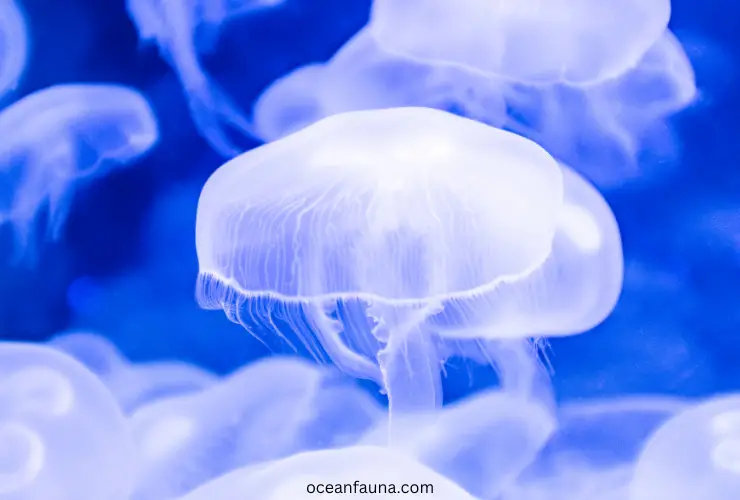
Importance of Moon Jellyfish In Ecosystem
Moon jellyfish play an important role in marine ecosystems as predators and prey.
As predators, they feed on various small organisms, helping to control their populations and maintain a balance in the food chain.
In turn, they are preyed upon by a variety of predators.
Moon jellyfish are also important indicators of environmental health.
They are sensitive to changes in water temperature, salinity, and pollution levels. Their abundance and distribution can provide valuable information about the health of marine ecosystems.
Predators of Moon Jellyfish
Moon jellyfish are known for their potent venom and are feared by many as one of the deadliest creatures in the ocean. Luckily, they are not invincible and have several natural predators that help to keep their populations in check.
One of the main predators of moon jellyfish is the sea turtle. All 8 species of sea turtles are known to feed on moon jellyfish.
These turtles have specialized adaptations that allow them to consume jellyfish without being stung by their venomous tentacles.
Other common predators of moon jellyfish include birds and fish, including whale sharks, triggerfish, or sunfish. These fish are able to avoid the jellyfish’s tentacles or use their powerful jaws to crush their bodies before consuming them.
Relationship between Moon Jellyfish And Humans
Moon jellyfish (Aurelia Aurita) have little direct interaction with humans. They do have a few important relationships and interactions with human activities.
One of the most significant relationships between moon jellyfish and humans is their impact on the fishing industry.
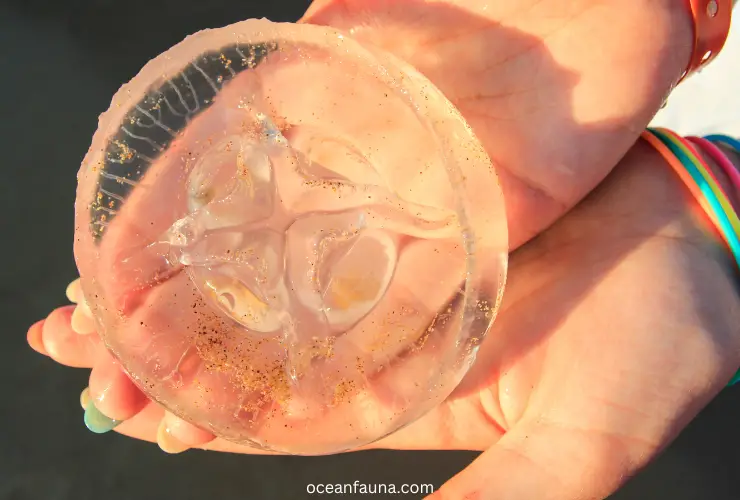
Moon jellyfish consume small fish and plankton, which can reduce the overall population of these organisms in the water.
This can have a negative impact on fish populations, as well as on the livelihoods of fishermen who depend on those fish for their income.
On the other hand, moon jellyfish are also used by humans in some ways.
For example, in some parts of the world, moon jellyfish are harvested and processed as a food source.
They are also used in scientific research to study marine biology and ecology.
In terms of direct interactions with humans, moon jellyfish are generally harmless.
Their sting is usually mild and does not cause serious harm to humans. However, some people may experience an allergic reaction to the jellyfish venom, which can cause more severe symptoms.
Moon jellyfish are also sometimes kept as pets in the home aquarium.
Threats to Moon Jellyfish
Moon jellyfish face a variety of threats in their natural habitats.
Pollution, Overfishing and Habitat Destruction
Some activities can pose a threat to moon jellyfish populations, such as pollution and habitat destruction.
Overfishing can have an impact on moon jellyfish populations.
When larger predators are removed from the ecosystem, smaller organisms like jellyfish can thrive and reproduce at higher rates, potentially leading to imbalances in the ecosystem.
In addition, human activities such as coastal development and recreational activities can disrupt the habitats where moon jellyfish live and feed. Nets and other fishing gear can also accidentally trap and kill jellyfish.
In addition, jellyfish blooms can impact human activities such as fishing and tourism, as large numbers of jellyfish can clog fishing nets and deter swimmers from entering the water.
Climate Change and Global Warming:
One of the biggest threats to their survival is climate’s harsh effect, which can harm their delicate bodies and disrupt the balance of their ecosystems.
Climate change can cause ocean temperatures to rise and alter the chemistry of the water, potentially harming jellyfish and other marine organisms.
Moon jellyfish are commonly found in coastal areas and can survive in a wide range of temperatures.
However, changes in ocean temperatures caused by global warming can have negative effects on their growth and reproduction.
The ocean’s acidity has also increased due to the absorption of excess carbon dioxide from the atmosphere, which can be harmful to moon jellyfish and other marine organisms.
Moon Jellyfish on Florida’s Gulf Coast
Moon jellyfish are commonly found in the Gulf of Mexico, including Florida’s Gulf Coast.
The increase in the moon jellyfish populations can be attributed to the south winds and sunny weather, which increase the nutrient content of the water.
The abundance of nutrients leads to an increase in the jellyfish population.
However, when moon jellyfish populations become too large, they can create problems for local ecosystems by consuming plankton and small fish, which can disrupt the food chain.
In addition, the decomposing bodies of moon jellyfish can deplete oxygen levels in the water, causing “dead zones” where marine life cannot survive.
Moon jellyfish migration patterns have been observed in the late summer and early fall months. The jellyfish stay on Florida’s Gulf Coast until the weather changes with the Northern wind and rainfall.
FAQs
Can moon jellyfish glow in the dark?
Yes, moon jellyfish can glow in the dark. They have bioluminescent proteins called photoproteins, which they use to produce a greenish-blue light.
Is it ok to pick up a moon jellyfish?
It is generally safe to pick up a moon jellyfish with bare hands as they are not considered dangerous to humans. However, it is recommended to handle them with care to avoid damaging their delicate bodies.
What happens when a moon jellyfish dies?
When a moon jellyfish dies, its body decomposes and releases nutrients into the water, benefiting other marine organisms.
Conclusion
Moon jellyfish are amazing creatures that play an important role in marine ecosystems.
However, the effects of climate change and ocean acidification can have negative impacts on their growth and reproduction.
It is important to take action to reduce greenhouse gas emissions and mitigate the impacts of global warming on the ocean to protect moon jellyfish and other marine species.

